We don’t typically pay a whole lot of attention to motocross bikes here at MD, but the 2019 Kawasaki KX450 caught our eye when we saw the press release this morning. This is, essentially, an entirely new motorcycle … redesigned from the ground up. It is also the first motocross bike from Kawasaki to feature electric start.
Despite the new starter motor and battery, the new KX450 still comes in at a svelte 232.4 pounds dry. In all, Kawasaki presents a new engine, new frame (slimmer), new suspension, new hydraulic clutch, and several other new features described in the detailed press release that follows. Kawasaki says the bike is available now at U.S. dealers at an MSRP of $9,299.
Here is the press release from Kawasaki:
The Kawasaki KX™ lineup has an unmatched history of success and has paved the path to championships for the motocross heroes of today, while continuing to serve as the ultimate tool for the future stars of tomorrow. The KX family is the most dominant motocross and supercross brand of motorcycle available today, led by its flagship model the KX™450. The all-new 2019 KX450 weighs in at 232.4 lbs without fuel while boasting a powerful engine, nimble handling, and technologically advanced features that are derived directly from the motorcycles used by Kawasaki’s factory race team. All-new features for 2019 include a new lightweight, more powerful engine, new slimmer aluminum frame, new Showa coil spring front forks with A-KIT technology, new hydraulic clutch and new electric start system.
The KX450 motorcycle is the bike that builds champions. Kawasaki racers also receive the benefit of the industry-leading Team Green™ support network that can be found trackside at events across the nation. The Kawasaki KX450 is notorious for asserting its championship proven dominance across the world.
ENGINE
- NEW Kawasaki’s first electric start motocross bike
- NEW hydraulic clutch
- NEW finger-follower valve train designed by Kawasaki’s World Superbike engineers
- NEW aggressive cam profiles
- NEW larger intake and exhaust valves
- NEW lightweight bridged-box piston
- NEW thinner air cleaner element
- NEW downdraft-style intake routing
- NEW longer exhaust header pipe
- NEW larger 44 mm throttle body
- NEW change drum and shift fork reduce weight
- NEW plain bearings for the connecting rod big-end
- NEW compact fuel pump
The engine of the KX450 has always been strong, and the lightweight engine package is even stronger in 2019 thanks to the input from the factory race team. The four-stroke, single cylinder, DOHC, water-cooled 449 cc engine has increased peak power and a flatter torque curve that makes it easier to get on the gas sooner.
New for 2019, the KX450 becomes Kawasaki’s first motocross bike with an electric start, which is activated by the push of a button located on the handlebar near the right grip making starting easy and convenient. A lightweight, compact Li-ion battery helps keep weight down, as does an automatic centrifugal decompression system fitted to the exhaust cam, which lifts one exhaust valve to facilitate starting.
In addition to an electric start, the KX450 also becomes Kawasaki’s first motocross bike equipped with a hydraulic clutch. The new clutch offers a more direct feel and an easier pull for lighter lever action, helping to reduce fatigue while on the racetrack. The hydraulic clutch is designed to provide a more consistent feeling through minimal change in clutch play as the clutch heats up during heavy use.
Kawasaki brought top-level road racing technology to the KX450 valve train, using designs from Kawasaki World Superbike engineers. It uses finger-follower valve actuation, enabling larger-diameter valves and more aggressive cam profiles. Thanks to the finger-follower valve actuation, the rev-limit has been raised, contributing to increased high-rpm performance. The change to finger-follower valve actuation reduces the valve train mass and friction compared to a tappet-style valve actuation. A DLC coating on the finger followers helps protect against wear.
Complementing more aggressive cams, larger 40 mm intake valves and 33 mm exhaust valves with increased lift help air flow and contribute to increased power. Valves are formed from lightweight titanium, reducing reciprocating weight and offering high-rpm reliability. Chromium steel valve spring retainers and a highly durable chromium nitride coating on the camshafts improve reliability at high-rpm. The lightweight bridged-box piston uses the same design as the Monster Energy® Kawasaki race team’s factory race bikes, contributing to strong performance throughout the entire rpm range. The revised piston design reduces weight and optimizes strength for durability.
The cylinder is offset 8.5 mm forward to reduce mechanical loss through friction from the piston movement, enabling more efficient power generation. A special coating used on the intake port cores during the casting process make ports ultra-smooth, which increases efficiency and performance throughout the rpm range.
The new header pipe length has been increased by 105 mm to match the updated engine package and improves low-end power. A resonator chamber fitted to the exhaust system header effectively increases exhaust pipe length and helps reduce the decibel sound level. A new thinner air cleaner element improves air flow, contributing to increased performance at all rpm. New downdraft-style intake routing allows an even straighter approach for intake air into the cylinder, improving cylinder-filling efficiency and contributing to increased engine power. The new 44 mm throttle body is now larger and features reversed orientation of the butterfly for better fuel atomization from the top mounted injector. A new fine atomizing, 12-hole injector now sprays 75 micron droplets and flows over 20 percent more fuel to contribute to increased power, smooth power delivery and superb engine response at partial throttle.
A close-ratio five-speed transmission features lightweight gears and shafts to keep weight down, yet retain strength, while contributing to the motorcycle’s winning performance. Revisions have been made to the shift drum and shift fork, resulting in a weight savings. The engine cases, which feature a scavenger pump on the right case, have been constructed of extremely light materials and are designed to meet the highest standards of durability. A change from needle bearings to plain bearings for the connecting rod big-end reduces mechanical loss, contributing to overall performance.
The new lightweight fuel pump is located in the plastic fuel tank and has a revised design that is more compact, enabling a flatter design for the top of the tank.
DFI® COUPLERS
- NEW Ability to adjust mapping while engine is running
Contributing to the race-winning engine characteristics, the digital fuel injection system of the KX450 features a coupler package that has set the industry standard. Each KX450 motorcycle comes standard with three different couplers, easily allowing riders to select pre-programmed fuel injection and ignition mapping to suit their riding style or track conditions. The four-pin DFI® couplers select maps that are designed for standard, hard or soft terrain settings. Changing the engine map is as simple as connecting the coupler cap of choice. For riders looking to fine tune their ECU settings, the KX FI Calibration Kit (Handheld) is offered as a Kawasaki Genuine Accessory, and provides access to the fully programmable ECU. The handheld device eliminates the need for a trackside laptop and gives riders the ability to create custom maps for precise adjustment of fuel and ignition settings. The user-friendly device can store up to seven preset maps and is PC-compatible. For 2019, maps can now be changed while the engine is running by changing couplers, eliminating the need to shut off the engine.
LAUNCH CONTROL
The launch control system of the KX450 motorcycle is a favorite for riders who are focused on getting to the first turn ahead of their competition. The push-button activation retards ignition timing in first and second gear, helping maximize traction and put the bike’s potent power to the ground. Once the rider shifts into third gear, normal ignition mapping immediately resumes and full power is restored.
CHASSIS
- NEW slimmer aluminum perimeter frame
- NEW engine used as a stressed member for rigidity balance
- NEW swingarm with revised rigidity to match the main frame
Kawasaki’s engineering team has worked closely with the factory racing team to develop an industry-leading slim aluminum perimeter frame that is capable of providing precise cornering through excellent front-end feel and the ultimate agility at high speeds. As an evolution of the current design, the new frame boasts increased overall rigidity balance. The frame’s lightweight construction is composed of forged, extruded and cast parts, while the engine is used as a stressed member and adds to the frames rigidity balance. The overall rigidity balance has been increased through a new steering head area with optimized rigidity, main frame rails with revised cross-section, and a revised line for the swingarm brackets. Lower frame rails have been widened and also contribute to the bikes overall rigidity balance. Forged chain adjusters are also equipped with a self-locking rear axle nut. The axle nut holds 80 lb-ft torque without the need of a cotter pin, simplifying maintenance at the track.
The KX450 motorcycle also features a new lightweight swingarm that has revised rigidity and was designed to match the frame, and contributes to increased traction at the rear wheel. The alloy swingarm is constructed of a cast front section and twin tapered hydro-formed spars in a raw aluminum finish. With center of gravity and balanced handling in mind, engineers carefully placed the dimension of the swingarm pivot, output sprocket, and rear axle locations, so that the rear tire would drive the bike forward.
SUSPENSION & BRAKES
- NEW Showa 49 mm coil spring fork with A-KIT technology
- NEW revised linkage ratios
- NEW rear shock layout and Uni-Trak® rear suspension
- NEW front brake master cylinder
- NEW larger 250 mm rear disc
- NEW rear brake master cylinder and hose
- NEW larger-diameter 22 mm front axle
For 2019, the KX450 motorcycle is equipped with new high-performance Showa 49 mm coil spring front forks with A-KIT technology, which feature large diameter inner tubes that are the same size as those found on Kawasaki’s factory racing team’s bikes and enable the use of large damping pistons for smooth action and firm damping. A hard titanium coating on the outer surface of the fork inner tubes helps prevent wear abrasion. The increased surface hardness of the dark navy blue coating also helps to prevent scratches and damage to the tubes. As a result of the surface remaining smoother for a longer period, the reduction of friction creates a smoother and more enjoyable ride. A Showa “Dimplush™” finish process plus Kashima Coat creates a micro-dimpled surface on the inner walls of the outer fork tubes to improve oil retention, and helps prevent wear abrasion on the inside of the tubes, ensuring the sliding surfaces remain smooth for a long time, while the outside is protected against corrosion. The A-KIT technology used in valving, surface treatments and finishes, contributes to noticeably smoother suspension action at the initial part of the stroke and a better ride feel. Incredibly precise personalized settings can be found with 16-position compression and 16-position rebound adjustments.
On the rear suspension, a new Kawasaki Uni-Trak® linkage system is designed to work in conjunction with the new shock, new aluminum frame and new swingarm. The linkage, which is mounted below the swingarm, allows for a longer rear suspension stroke and allows more precise rear suspension tuning. The linkage ratios have been revised to help keep the rear wheel planted for increased traction. The Showa shock layout has been shifted 5 mm to the right to allow room for the new downdraft-style engine intake and increases rear wheel traction. The new Showa Compact Design rear shock has A-KIT technology with bigger diameter compression adjuster, improving damping on the high frequency movements found on today’s motocross tracks. Dual compression adjustability can be found on the rear shock, allowing high-speed and low-speed damping to be adjusted separately. The fully adjustable shock allows for settings to be personalized for riding preference and conditions.
An oversized 270 mm, petal-shaped front brake rotor from the renowned manufacturer, Braking, is fitted to keep up with the powerful engine of the KX450 and help riders brake harder and later than the competition. The front brake master cylinder has been revised and offers better initial control, while contributing to overall braking performance and consistency. The rear is equipped with a new larger-diameter 250 mm petal-shaped Braking® rotor that matches the large front disc and contributes to stronger stopping power. The rear brake master cylinder and hose have been revised to reduce weight.
Derived from Kawasaki’s factory racing efforts, front-end traction has been improved thanks to a new larger-diameter 22 mm front axle shaft. Dunlop MX3S tires contribute to increased front and rear traction.
ADJUSTABILITY
- NEW lighter and wider footpegs
Kawasaki continues its unmatched commitment towards providing riders with class-leading ERGO-FIT™ comfort thanks to its adjustable handlebar mounting system and footpegs to fit a variety of riders and riding styles. The handlebars feature four-way adjustable mounts. The multi-position handlebars offer two mounting holes with 35 mm of adjustability, and the 180-degree offset clamps boast four individual settings to suit different size riders. The new lighter footpegs are 5 mm wider and positioned 3 mm further rearward, offering excellent grip and making it easier to weight the pegs. The footpegs feature dual-position mounting points, with a lower position that reduces the standard setting by an additional 5 mm. The lower position effectively lowers the center of gravity when standing, and reduces knee angle when taller riders are seated.
BODYWORK & SEAT
- NEW bodywork designed to facilitate rider movement
- NEW slimmer single piece radiator shrouds
- NEW flatter and lower fuel tank
- NEW smooth engine covers
Complementing its championship proven technology, the 2019 KX450 motorcycle features aggressive styling along with in-mold graphics on the radiator shrouds that result in an ultra-smooth surface and racy look needed to finish at the top of its class. The sleek bodywork has been molded to match the V-mounted radiators and narrow chassis design. The flatter fuel tank design allows the tip of the seat to be 20 mm lower and gives the rider greater freedom of movement when changing riding position, and facilitates sitting farther forward.
Each piece of bodywork has been designed to help facilitate rider movement with long, smooth surfaces that make it easy to slide back and forth. New single piece shrouds are slimmer where they come to contact with the rider’s legs and are easier to hold on to. Seams between the shrouds, seat, and side covers are nearly flush in order to increase bike control as well as moving around on the motorcycle.
Adding to the distinctive Kawasaki factory race team look is a green oil cap, generator cover plugs, green alumite suspension adjusters, and black alumite wheels. Engine covers were designed to be smooth in order to not impede rider movement.
The 2019 Kawasaki KX450 motorcycle can easily be made to suit a large range of riders thanks to its flat seat design, adjustable handlebar and footpegs and adjustable suspension components. This perfectly complements the wide range of damping settings as well as the DFI couplers and optional handheld KX FI Calibration Kit, allowing the rider to find the ideal engine characteristics to suit a particular track or conditions. While the base settings on the KX450 motorcycle are based on extensive testing and racing, the motorcycle provides a huge range of technology and adjustment to help ensure every rider can experience the incredible ability of this extremely capable motocross bike.
CONTINGENCY
Kawasaki Team Green Racing Contingency for 2019 supercross, motocross, and off-road racing are set to be announced and include the all-new KX450. Highlights of the contingency program include increased payouts in off-road racing and more privateer support in both supercross and motocross.
Color: Lime Green
MSRP: $9,299
Availability: Now
See more of MD’s great photography:
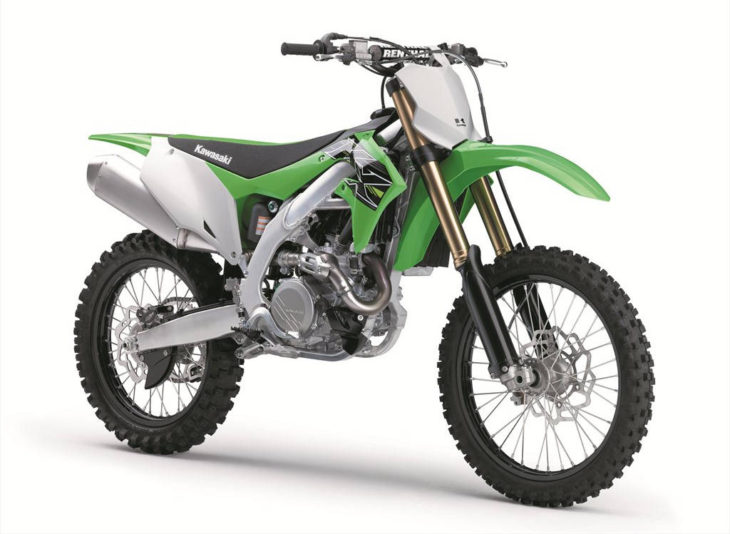

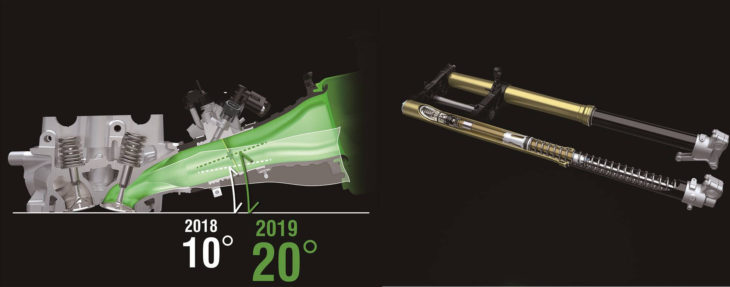
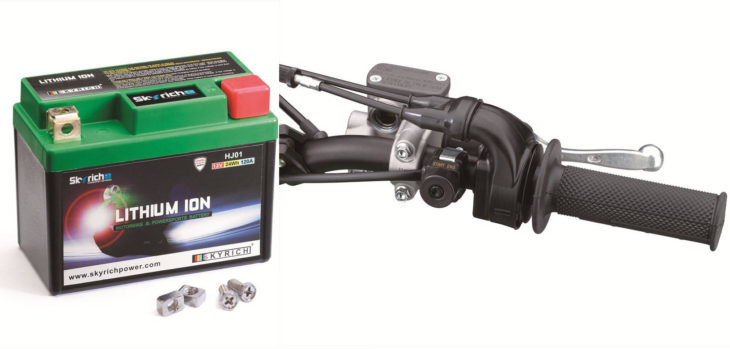
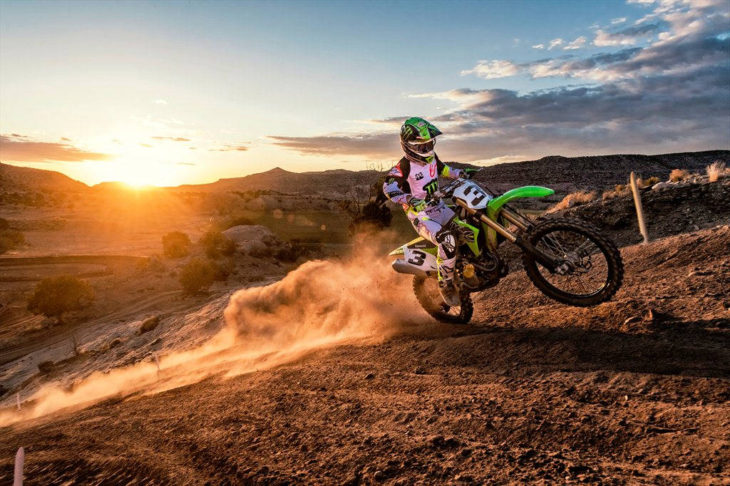
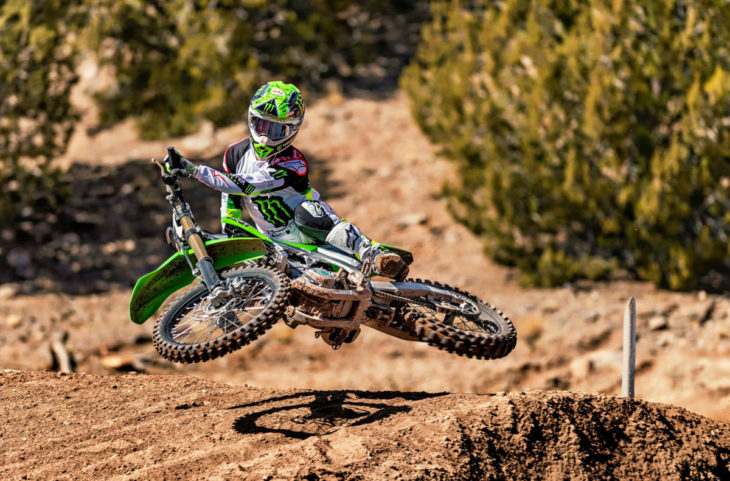
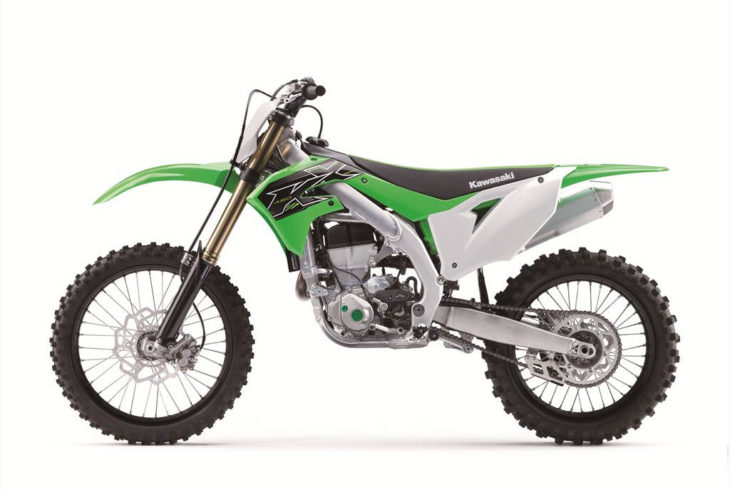






Looks to be a nice bike with some good updates. However, the 450’s have too much power for what I need. The kx250F has good power for me but is too loud. In my younger days I did not want e-start to save weight. Now I only want e-start.
Will definitely be interested to see if Kawasaki morphs this bike into off-road and dual sport versions a la Honda’s recent move. Would add even more color to the market.
Looks like I will be sticking with my enhanced 2002 CR250R (which is still in great shape).
I have been a Kawasaki rider for years, and reading these articles KTM looks like they are making big strides in the market. I will look at the KTM more closer after reading this article. Thank you motorcycle daily.
Motocross Action test of this bike.
https://m.youtube.com/watch?v=eBT4f4eNEAM
These manufacturers are sniffing too much brake fluid if they think everyone who rides needs to pony up to a $10k bike. A 250 2 stroke is plenty fast for weekend warriors and much easier on the wallet.
Nearly 20 years after they told us ‘the writing is on the wall, two strokes will be outlawed,’ and 2 strokes haven’t gone anywhere, even in California. If their goal was to make motocross look like Superbike racing, with half empty grids, then I guess four strokes have been an overwhelming success.
^brake cleaner^
Two strokes will disappear soon in CA. There are proposed changes to red stickered bikes that will effectively get rid of two strokes. Personally I think that’s a good thing, since those things pollute the air horribly.
People have been saying that since the early 2000’s and still nothing has happened. Do you have a web link to an article on this issue?
Also, KTM has injected two strokes that effectively run at 100:1 ratio, so 2 strokes can be made to run a lot cleaner than 32:1 with a carb. At that point the bike will surely cost more, but at least you don’t have to drop $1000 dollars into the thing every time a valve wears out like with thumpers.
Same thing happened in the outboard/Personal watercraft industries, but two strokes are still alive and well.
The technology is out there to make smokers compliant. KTM/ Husky are already prepared with their fuel/oil injection system, because they are actually in touch with the grass roots of the sport.
“These manufacturers are sniffing too much brake fluid if they think everyone who rides needs to pony up to a $10k bike.”
They don’t think everyone needs to. Nor does Ford think everyone needs to spend $60K for a 1/2 ton pickup truck with a diesel. Prices are based on supply, demand, what the market will bear, and what the competition charges for competing products.Some consumers will buy those vehicles and some won’t.
Ford isn’t the best company for comparison purposes(since they will stop offering many models in the US, soon), so I’ll use Toyota as an example.
Not everyone needs a V8 Tundra, so the Tacoma is available so that people who want a truck can have something that fits their needs more perfectly. 125 and 250 two strokes are like the Tacoma, and Thumpers are like a V8 Tundra. Toyota would sell a lot less vehicles overall if they only sold big V8 trucks.
No, a lot of people will be well served by the 2016-2018 generation KX450Fs that will we traded in for these 9200-dollar bikes. And a lot of riders will buy the older bikes that are traded in by those folks. That is also a big part of how the consumer affords a new bike: a thriving second-hand market. These are not disposable trash after a year.
These 450s are a lot easier to ride than the 250 two-strokes and offer great value and longevity. That is why they sell.
KLX 450 SF?
Now just take that motor and put it in a retro standard. Kawasaki Z450RS.
While I’m sure these current motocross bikes are all better than decades before, I’m glad I raced back when great race bikes retailed for around $1595 for a 250. Along with the cost of a new bike now a days, and the much more expensive gear for riding, not to mention I’m sure the sign-up costs and whatever else, I couldn’t afford to race anymore. Everyone can’t get sponsors either, you have to be so good, and then it’s difficult in places to get meaningful sponsorship.
Ummmm…When did dirt bikes get to be $10K? Day-um.
I need this bike
it will make me ride faster
I will be awesome and the envy of all my friends….voice inside my head….you have no friends….also voice inside my head
All it would take is a headlight, turn signals, horn, license plate holder, and titanium fuel tank, and we could have a whole new argument about how much a truly dirt-oriented dual sport should cost.
All kidding aside, I have to wonder if the electric start doesn’t give away future intentions, depending on how well Honda’s new 450 DS does. H, & S’s large thumpers are pretty long in the tooth, I’d be surprised if the DMV wouldn’t give you antique plates for Honda’s 650L right off the showroom floor – one of these days, the EPA may say “time’s up” for machines with air-cooled, carbureted motors (with pistons not made from carbon fiber, hat tip to Tom R.).
Finally, do those squiggles actually count as brake “discs”? I’ve got to start paying better attention.
“All kidding aside, I have to wonder if the electric start doesn’t give away future intentions”
I don’t think so. Electric starting is just something that you now need to have in a competitive (in the market place) motocross bikes. Even the 250s have it. I doesn’t mean that a dual sport is not coming, though.
Must be lighter. Just make everything on the bike out of carbon fiber. Frame, seat, pistons, wheels, tires, chain, valve stems, bearings, wheel balancing weights, everything! And find a way to make carbon fiber combustible, and use it for fuel!
It would weight what, 67 pound maybe? That would make for some serious “Mine is the lightest bike” bragging rights.
Congratulations Kawasaki, you managed to engineer a rear axle nut without a cotter pin! Well done, just a couple of decades after the competition. Just kidding. The new bike looks great and it nice to see that Kawasaki kept the weight advantage it had among the Japanese bikes. The difference was not negligible in 2018.
The Honda weight is curb weight, that is all fluids, etc included. The Kawasaki weight is without fuel. Add a couple gallons of fuel, ~13 pounds, and the weight difference is negligible. Same with the Yamaha, they report curb weight.
I counted the word “New” at least 29 times for this “Completely Redesigned” motorcycle.
Did they re-invent the wheel while they were at it?
MX bikes seemed to change ever 2 years. Inbetween years, its minor improvements, adding to the stock bike, known improvements. Many times, “New” may not be an improvement, but indeed a change of construction, meant to improve things. The finger follower in the head, is a big deal, if its made right. The frame changes, are difficult to know first off. Anyone can make a strong frame. Years past, many bikes would break the mount plates, and engine cases. All in the attempt to allow the bike to flex, creating a better handling machine. Where and how it flexes, isnt easy to translate into what needs to be built how. The Japanese are good at constantly fine tuning, experimenting. New, in that something is changed, if not better immediately, often points out what was lost in the change, something not seen so obviously before. New is good.
The biggest complaint I have with the changes MX bikes get year after year after year, is what “they” consider an improvement. Every year, they like to change the geometry a bit stating that it’s better than last year. For Who? The 120# supercross rider on their factory team that season? The 120# MXGP rider they have that season? The next year they change it based on another 120# supercross rider’s desires, and again the next year for a new rider.
.
For everyone else of normal stature that buys their own bike, only 1 out of 10 of those years actually agrees with their riding style. If you buy any of those other bikes, you’re spending more money on suspension upgrades and different offset trees and clamps to get it to handle well. Trust me, they are not actually improving the bike year after year after year. At least regarding the chassis.
They did a good job of keeping the weight down when adding electric start. Honda and Yamaha could take note, the crf450 weighs 248 pounds and the yz450 weighs 245.
Suzuki RMZ450 is 247 pounds without electric start, yikes!
KTM 450SXF is the featherweight of the class at 222 pounds with electric start.
The weight listed in the article is WITHOUT fuel and is stated as such. All the other bikes you listed and their weights are with fuel and fluids ready to ride per their websites. If you go to Kawasaki’s website it shows that this bike WITH fuel weighs 242.2 lbs. Not that much different than the other bikes. I couldn’t find the specs for the KTM but it is likely without fuel as well.
The weight listed in the article is WITHOUT fuel and is stated as such. All the other bikes you listed and their weights are with fuel and fluids ready to ride. If you go to Kawasaki’s website it shows that this bike WITH fuel weighs 242.2 lbs. Not that much different than the other bikes. I couldn’t find the specs for the KTM but is likely without fuel as well.
Sorry for the double post. I posted it once and it disappeared so I reposted it. And then the first one showed back up again later. A mystery to me.
The KTM is without fuel, so add another 12 pounds or so to that, but still the lightest.
KTM also has the biggest tank.